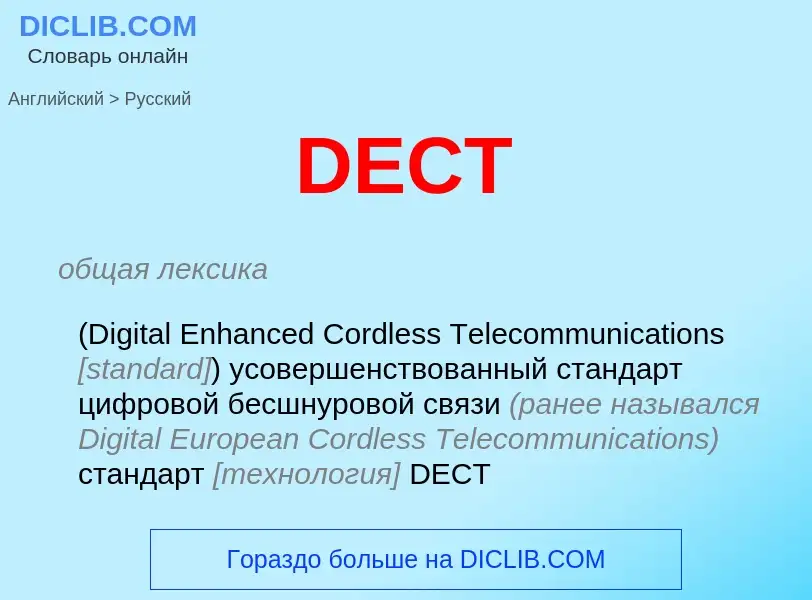Tradução e análise de palavras por inteligência artificial ChatGPT
Nesta página você pode obter uma análise detalhada de uma palavra ou frase, produzida usando a melhor tecnologia de inteligência artificial até o momento:
- como a palavra é usada
- frequência de uso
- é usado com mais frequência na fala oral ou escrita
- opções de tradução de palavras
- exemplos de uso (várias frases com tradução)
- etimologia
DECT - tradução para Inglês
общая лексика
(Digital Enhanced Cordless Telecommunications [standard]) усовершенствованный стандарт цифровой бесшнуровой связи (ранее назывался Digital European Cordless Telecommunications) стандарт [технология] DECT
задуманный изначально как единый европейский стандарт для домашних бесшнуровых телефонов, DECT стал одним из самых массовых стандартов цифрового радиодоступа в мире, поддерживающих голосовую и факсимильную связь, а также передачу данных. Оптимален для охвата относительно малых площадей с высокой концентрацией абонентов (до 100 000 абонентов на кв. км.). Стандарт опубликован ESTI в 1992 г., с 1993 г. становится приоритетным стандартом для всех стран ЕС и принят в качестве стандарта более чем в ста странах мира. Вторая редакция стандарта появилась в 1995 г. Использует диапазон частот 1880-1900 МГц и 10 несущих частотных каналов, в пределах каждого канала данные передаются пакетами по 480 бит через 12 дуплексных временных интервала, общая скорость передачи - 1152 Кбит/с (120 речевых каналов). Используется механизм динамического выбора каналов (см. DCS 4)). Базируется на расширенном TDMA, совместим с основными панъевропейскими стандартами для сетей связи общего пользования - euroISDN и GSM
(Digital Enhanced Communication Technology) другая расшифровка этой аббревиатуры
Смотрите также
общая лексика
Continuous Dynamic Channel Selection
непрерывный динамический выбор канала
механизм выбора каналов в DECT
Wikipédia

Digital enhanced cordless telecommunications (Digital European cordless telecommunications), usually known by the acronym DECT, is a standard primarily used for creating cordless telephone systems. It originated in Europe, where it is the common standard, replacing earlier cordless phone standards, such as 900 MHz CT1 and CT2.
Beyond Europe, it has been adopted by Australia and most countries in Asia and South America. North American adoption was delayed by United States radio-frequency regulations. This forced development of a variation of DECT called DECT 6.0, using a slightly different frequency range, which makes these units incompatible with systems intended for use in other areas, even from the same manufacturer. DECT has almost completely replaced other standards in most countries where it is used, with the exception of North America.
DECT was originally intended for fast roaming between networked base stations, and the first DECT product was Net3 wireless LAN. However, its most popular application is single-cell cordless phones connected to traditional analog telephone, primarily in home and small-office systems, though gateways with multi-cell DECT and/or DECT repeaters are also available in many private branch exchange (PBX) systems for medium and large businesses, produced by Panasonic, Mitel, Gigaset, Cisco, Grandstream, Snom, Spectralink, and RTX. DECT can also be used for purposes other than cordless phones, such as baby monitors and industrial sensors. The ULE Alliance's DECT ULE and its "HAN FUN" protocol are variants tailored for home security, automation, and the internet of things (IoT).
The DECT standard includes the generic access profile (GAP), a common interoperability profile for simple telephone capabilities, which most manufacturers implement. GAP-conformance enables DECT handsets and bases from different manufacturers to interoperate at the most basic level of functionality, that of making and receiving calls. Japan uses its own DECT variant, J-DECT, which is supported by the DECT forum.
The New Generation DECT (NG-DECT) standard, marketed as CAT-iq by the DECT Forum, provides a common set of advanced capabilities for handsets and base stations. CAT-iq allows interchangeability across IP-DECT base stations and handsets from different manufacturers, while maintaining backward compatibility with GAP equipment. It also requires mandatory support for wideband audio.
DECT-2020 New Radio, marketed as NR+ (New Radio plus), is a 5G data transmission protocol which meets ITU-R IMT-2020 requirements for ultra-reliable low-latency and massive machine-type communications, and can co-exist with earlier DECT devices.



